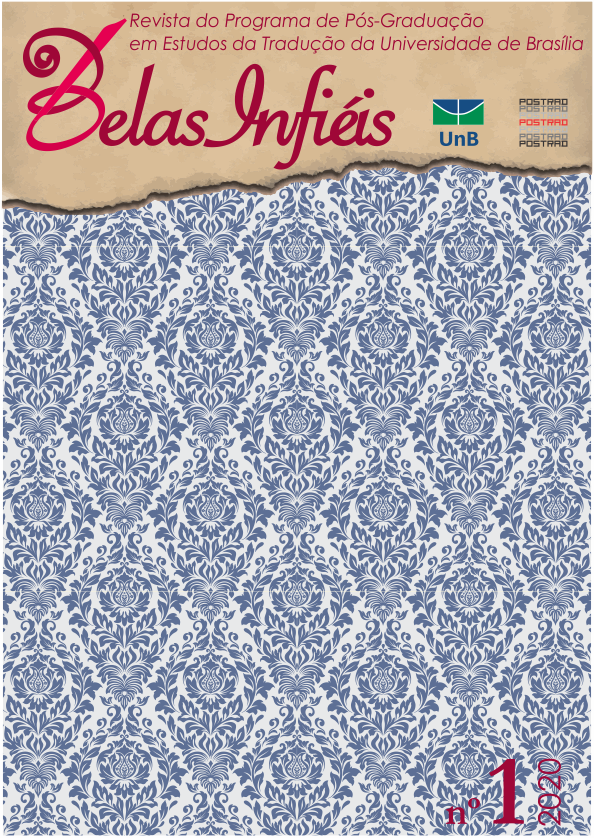Motives and perceived benefits of learning translation: A preliminary investigation of non-native EFL student teachers
DOI:
https://doi.org/10.26512/belasinfieis.v9.n1.2020.26851Keywords:
EFL teacher education. Student teachers. Learning motives. Language and translation.Abstract
The relationship between the teaching of English as a foreign language (EFL) and translation have been loosely entwined for a very long time. However, in the past decade, a number of academics have developed a renewed interest in the interplay between the two, and some teacher education universities offer translation courses to their student teachers. This paper presents findings from a preliminary study in which a questionnaire survey was used to identify the motives and perceived benefits of learning translation of 40 non-native EFL student teachers whose first language is Chinese, in a teacher education university in Hong Kong. The findings indicate that the pre-service teachers decided on taking translation courses or taking the subject as a minor because of their interest in both Chinese and English and their eagerness to improve their proficiency in these languages. The belief that learning translation might help non-native EFL student teachers secure a job in a language-related field is another prime motive for them to learn translation. It was discerned that they perceive learning translation to be beneficial to both their Chinese and English proficiency, especially in the knowledge of English grammar, and they have benefited in bilingual competence and career options. The paper concludes that although EFL student teachers tend not to work as professional translators after graduation, learning translation is deemed to have provided them with multifaceted benefits and increased their competitiveness in language-related fields.
Downloads
References
Astin, A. W. “Student Involvement: A Developmental Theory for Higher Education.” Journal of College Student Development, vol. 40, no. 5, 1999, pp. 518-529.
Babad, E., and A. Tayeb. “Experimental Analysis of Students’ Course Selection.” British Journal of Educational Psychology, vol. 73, no. 3, 2003, pp. 373-393.
Cheng, L., and H. Wang. “Understanding Professional Challenges Faced by Chinese Teachers of English.” TESL-EJ 7, vol. 4, 2004, pp. 16-31.
Choi, E., and J. Lee. “Investigating the Relationship of Target Language Proficiency and Self-efficacy among Non-native EFL Teachers.” System, vol. 58, 2016, pp. 49-63.
Cook, G. Translation in Language Teaching: An Argument for Reassessment. Oxford: Oxford University Press, 2010.
Creese, A, and A. Blackledge. “Translanguaging in the Bilingual Classroom: A Pedagogy for Learning and Teaching?” The Modern Language Journal, vol. 91, no. 1, 2010, pp. 103-115.
Curriculum Development Council. English Language Education Key Learning Area: English Language Curriculum Guide (Primary 1-6). Hong Kong: Education and Manpower Bureau, 2004.
Hedges, M. R., G. A. Pacheco, and D. J. Webber. “What Determines Students’ Choices of Elective Modules?” International Review of Economics Education, vol. 17, 2014, pp. 39-54.
Ho, W. C., and W. W. Law. 2002. “Music Education in Taiwan: The Dynamics and Dilemmas of Globalization, Localization and Sinophilia.” Curriculum Journal, vol. 13, no. 3, 2014, pp. 339-360.
Hopkins, M. “Building on Our Teaching Assets: The Unique Pedagogical Contributions of Bilingual Educators.” Bilingual Research Journal, vol. 36, no. 3, 2013, pp. 350-370.
Law, Z. “Job Uncertainty Gnaws at Hong Kong’s Contract Teachers in Public Schools and Causes Low Morale.” South China Morning Post, July 13, 2018.
Li, D.F. “Needs Assessment in Translation Teaching: Making Translator Training More Responsive to Social Needs.” Babel, vol. 46, no. 4, 2000, pp. 289-299.
---. “Language Teaching in Translator Training.” Babel, vol. 47, no. 4, 2001, pp. 343-354.
Lung, R. “Translation Training Needs for Adult Learners.” Babel, vol. 51, no. 3, 2005, pp. 224-237.
Lung, R., and J. Yan. “Attitudes Towards a Literature-oriented Translation Curriculum.” Babel, vol. 50, no. 1, 2004, pp. 3-12.
Movchan, L., and I. Zarishniak. “The Role of Elective Courses in Students’ Professional Development: Foreign Experience.” Comparative Professional Pedagogy, vol. 7, no. 2, 2017, pp. 20-26.
Nault, D. “Going Global: Rethinking Culture Teaching in ELT Contexts.” Language, Culture and Curriculum, vol. 19, no. 3, 2006, pp. 314-328.
Pugach, M. C., L. P. Blanton, and V. I. Correa. “A Historical Perspective on the Role of Collaboration in Teacher Education Reform: Making Good on the Promise of Teaching All Students.” Teacher Education and Special Education, vol. 34, no. 3, 2011, pp. 183-200.
Pym, A. “Where Translation Studies Lost the Plot: Relations with Language Teaching.” Translation and Translanguaging in Multilingual Contexts, vol. 4, no. 2, 2017, pp. 164-189.
Sinclair, C. “Initial and Changing Student Teacher Motivation and Commitment to Teaching.”. Asia-Pacific Journal of Teacher Education, vol. 36, no. 2, 2008, pp. 79-104.
Swain, M., A. Kirkpatrick, and J. Cummins. How to Have a Guilt-free Life Using Cantonese in the English Class: A Handbook for the English Language Teacher in Hong Kong. Hong Kong: Research Centre into Language Acquisition and Education in Multilingual Societies, Hong Kong Institute of Education, 2011.
Tang, Y. F. “Teachers’ Professional Identity, Educational Change and Neo-liberal Pressures on Education in Hong Kong.” Teacher Development, vol. 15, no. 3, 2011, pp. 363-380.
Tsagari, D., and G. Floros, eds. Translation in Language Teaching and Assessment. UK: Cambridge Scholars Publishing, 2013.
Tsai, Y., and A. Tsai. “Xue sheng xuan xiu fan yi ke cheng de xue xi dong ji tan tao å¸ç”Ÿé¸ä¿®ç¿»è¯èª²ç¨‹çš„å¸ç¿’動機探討.” Tamkang Studies of Foreign Languages and Literatures, vol. 20, 2012, pp. 57-72.
Yu, Li. “Communicative Language Teaching in China: Progress and Resistance”. TESOL Quarterly, vol. 35, no. 1, 2001, pp. 194-197.
Downloads
Published
How to Cite
Issue
Section
License
Given the public access to this journal, the texts are free to use but requires the recognition of the original authorship and initial publication in this journal to be properly stated.
 The journal allows the use of works published for non-commercial purposes, including the right to submit the work to publicly accessible databases. Published contributions are the sole and exclusive responsibility of the author(s).Â



















